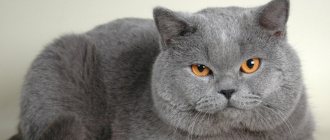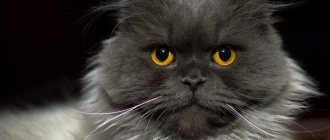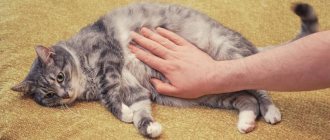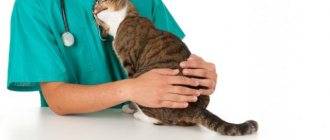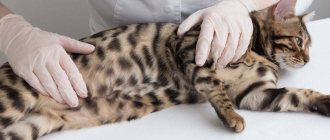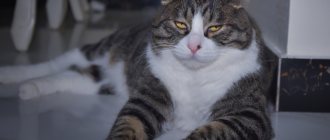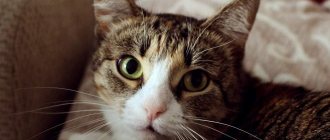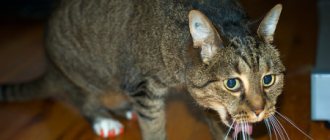Anemia is a clinical and hematological syndrome, which is a decrease in the number of red blood cells and hemoglobin per unit volume of blood. In this case, the volume of blood in the cat’s circulatory system may be within normal limits or even more.
Red blood cells (erythrocytes) are a special type of blood cell that contains hemoglobin - a complex protein that includes iron, which has the ability to bind incoming oxygen. During the process of breathing, oxygen entering the cat’s lungs from the surrounding air is adsorbed in the capillary network of the lungs by blood (erythrocytes), binding to the hemoglobin of erythrocytes. During circulation through the bloodstream, hemoglobin transfers oxygen to the tissues of the body, since without it, not a single biochemical reaction in animals occurs in the body. It is the hemoglobin in red blood cells that colors the blood its characteristic red color.
Red blood cells are produced in the bone marrow and released into the bloodstream, where they live for about two months. As red blood cells age, they are filtered from the circulatory system into the spleen. The iron found in red blood cells is recycled to create new red blood cells.
If a cat is anemic, the ability of its red blood cells to absorb oxygen in the lungs and deliver it to body tissues is reduced and the cat appears lethargic and weak.
Anemia in cats occurs for a number of reasons, which can be divided into four groups:
- The process of disrupting blood formation.
- Blood destruction disorder.
- Violation of the balance between the formation and destruction of blood cells.
- Genetic malfunction in the cat's body.
Depending on the cause that caused the pathological condition in the cat, veterinary specialists distinguish the following types of anemia:
- Nutritional.
- Hemolytic.
- Hypoplastic.
- Aplastic.
- Posthemorrhagic.
Characteristics of the condition and its features
Anemia is characterized not only by a decrease in the number of red blood cells, but also by a drop in the level of hemoglobin, an iron-containing protein involved in gas exchange. Due to lack of oxygen and excess carbon dioxide, all internal organs suffer. This affects immunity, acid-base balance, heart and kidney function.
The disease in mustachioed pets is much more acute than in humans. The thing is that it takes too much time for the body to restore red blood cells. But in case of mass death it is simply not there, so saving the animal without veterinary care is impossible.
Wide tapeworm
In severe cases of tapeworm infection, high fever and nausea occur.
Another dangerous flat parasite for humans, the broad tapeworm, causes a rather specific type of helminthiasis. We are talking about a disease called diphyllobothriasis.
This helminthiasis is distinguished by the long incubation period of its pathogen (it takes, on average, about two months for the worm to “take root” in the body). How is diphyllobothriasis diagnosed?
As a rule, the general condition of the patient with helminthiasis of this type is only slightly impaired. In some cases, the infected person may complain of slight dizziness or malaise, which appears only occasionally.
With a more severe form of infection that occurs with complications, the symptoms of diphyllobothriasis become more pronounced. The patient experiences an increase in body temperature (usually up to 37.5 degrees), nausea and diarrhea. Unpleasant, crusty rashes appear on the skin.
Most patients also complain of pain in the upper abdomen.
The easiest way to diagnose diphyllobothriasis is by assessing the condition of the patient’s oral cavity. Thus, when infected with a wide tapeworm, the mucous membrane of the host’s mouth becomes covered with bright red painful spots. A similar picture is observed in the tongue, where, in addition, atrophy of the taste buds can be noticed.
Types depending on the lack of a certain element
Symptoms and methods of treating anemia in cats depend on its type. The classification is based on the lack of a certain element.
Autoimmune (hemolytic)
Autoimmune, or hemolytic, anemia in cats develops when red blood cells are destroyed. Its main symptom is jaundice, caused by poisoning or disruption of hematopoietic processes.
Infectious
Infectious anemia in cats is caused by low hemoglobin concentrations caused by leukemia, immunodeficiency, salmonellosis, bartonellosis, or streptococcal infection. These diseases lead to malfunctions of the bone marrow.
Nutritional
This type of anemia often occurs in newborn kittens and animals younger than 1.5 years. Iron deficiency, associated with poor feeding or impaired absorption function, is to blame for its development.
Posthemorrhagic
Occurs due to internal and external bleeding, accompanied by loss of red blood cells and hemoglobin. Depending on the number and severity of wounds, it occurs in acute or chronic form. The main cause of this disease is flea infestations and helminthiasis.
Hypoplastic
Develops with a deficiency of vitamin B, iron, copper, cobalt and protein, as well as with toxin poisoning. Accompanied by a disorder of bone marrow functions.
Aplastic, or iron deficiency
Aplastic, or iron deficiency, anemia in cats is characterized not only by low levels of hemoglobin and red blood cells, but also by a reduction in the number of white blood cells. May be accompanied by an inflammatory process in the bone marrow or liver.
Preventive actions
To prevent anemia in a pet, the owner must follow a number of simple rules:
- You can provide your animal with complete and balanced nutrition and get specific recommendations regarding the diet of a particular breed from your veterinarian. A cat's diet should be rich in protein, so beef, chicken and turkey are a must. Also pamper your pet with offal twice a week. The liver is especially useful. Fermented milk products will ensure proper functioning of the intestines, and introduce vegetables as a source of iron, copper and vitamins.
- Give your pet the opportunity to splash out its energy; do not limit its activity.
- Carry out anthelmintic measures in a timely manner. Typically, anti-parasite medications need to be given to your cat once a quarter.
- Vaccinating your animal will help prevent diseases that cause anemia.
- Avoid contact between your pet and its stray relatives.
- Pay special attention to safety. All toxic substances and medications should be kept out of reach of the animal. When treating a living space with insecticides, it is necessary to exclude the cat from being there until the time recommended by experts.
- If signs of illness are detected, immediately show the cat to a doctor. It is more effective to treat any disease in the first stages. Therefore, you should not delay going to the veterinarian. The ideal option would be systematic preventive examinations by a specialist.
Causes of anemia in cats
All causes of anemia can be divided into 3 large groups. These include:
- Destruction of red blood cells in the systemic circulation. This group includes poisoning with poisons, drugs and decay products of malignant neoplasms, as well as viral infections and autoimmune pathologies.
- Loss of blood due to bleeding. This includes injuries, gastrointestinal diseases (ulcers), piroplasmosis and helminth infection.
- Insufficiency of hematopoietic organs. In addition to bone marrow, these include the liver and spleen. Develops in cases of deficiencies due to unbalanced nutrition, in chronic diseases of the gastrointestinal tract and endocrine system that impair their functionality.
The risk group includes the Somali and Abyssinian breeds. They most often suffer from congenital instability and deformation of red blood cells.
What symptoms indicate pathology?
Symptoms of illness appear almost immediately, which greatly simplifies diagnosis. These include:
- shortness of breath and rapid heartbeat;
- dilated pupils;
- paleness, blueness or yellowing of mucous membranes;
- apathy and fatigue;
- loss or perversion of appetite, expressed in eating inedible objects (filler, stones, paper);
- growth retardation in kittens;
- constipation and diarrhea with blood particles, involuntary urination;
- tarnishing and deterioration of wool quality;
- decreased body temperature;
- loss of consciousness.
All these symptoms are not specific. Because of this, anemia can be easily confused with other diseases. The only reliable way to diagnose anemia in cats is to take a blood test.
Prevention of anemia
The most important condition for preventing anemia in a kitten or adult cat is a balanced diet. This term refers to a varied diet, correctly selected portion sizes and number of meals.
The nutritional system is compiled individually, taking into account the age, weight, lifestyle and health status of the animal. Additionally, the animal can be given vitamin supplements; they are prescribed based on test results.
It is important to carry out regular prevention of flea and worm infestation. It is also necessary to vaccinate your pet according to the schedule approved by the veterinarian.
Anemia is a common blood disease among animals. The easiest way to normalize the condition is to review your cat's diet by adding foods rich in protein and iron. If your pet shows alarming signs of illness, you should immediately contact your veterinarian and get a blood test. Timely treatment increases the chances of success several times.
Diagnostics and test indicators
Using the results of general and biochemical blood tests, the preliminary diagnosis is confirmed or refuted. If an animal has anemia, the following is found:
- deviation of hemoglobin and (or) red blood cells downwards;
- a decrease in the level of hematocrit, which evaluates the transport function;
- a decrease in the amount of total protein, indicating blood loss;
- increased erythrocyte sedimentation rate (ESR) and reticulocyte count.
If an infection is suspected, a bacteriological examination is carried out, and if a deficiency of hematopoietic organs is suspected, a bone marrow puncture is taken.
A stool test, ultrasound and x-ray may also be required. With their help, you can detect parasites, neoplasms and other pathologies that impair the functionality of internal organs.
How to treat anemia in cats
Treatment of anemia in cats is aimed at eliminating the cause that caused it. In most cases, the prognosis is favorable. The only exception is diseases affecting the bone marrow.
Veterinary assistance
After making a diagnosis, the veterinarian decides how to treat anemia in a cat, choosing a conservative or surgical method. The second option is used for internal injuries and impaired bone marrow functionality. In all other cases, the following drugs are used:
- infusion solutions that stimulate the removal of toxins;
- antiviral and antibiotics that destroy the infectious agent;
- anthelmintics and other antiparasitic agents;
- hemostatic and coagulants that increase blood clotting;
- glucocorticosteroids that relieve inflammatory reactions;
- hepatoprotectors that restore liver cells and medications to normalize kidney function;
- immunosuppressants that suppress immunity in autoimmune pathologies;
- vitamins and immunomodulators that improve the body's defenses.
Iron-containing drugs are prescribed only after the source of the disease has been eliminated. Otherwise, they only aggravate the situation, creating favorable conditions for the nutrition of pathogenic microorganisms.
In addition to taking medications, it is important to take care of reviewing the existing diet in order to eliminate existing deficiencies. To understand the effectiveness of therapy, you will need to undergo regular tests to monitor changes in dynamics.
Diet during treatment
To increase hemoglobin, iron-fortified foods should be added to the diet. These include:
- sea fish;
- beef kidneys, heart, liver and meat itself;
- spinach;
- wheat bran;
- tomato juice.
To stimulate intestinal peristalsis, it is recommended to consume cottage cheese, yogurt and other fermented milk products with low fat content. Suitable vegetables include zucchini, bell peppers and pumpkin.
The chlorophyll contained in sprouted wheat has a particularly beneficial effect on hematopoiesis. You can grow this herb yourself or purchase it from pet stores. Rose hips also have similar properties, so in addition to regular water, you can add berry decoctions to your diet.
For dry-fed cats, dry food and wet canned food from the veterinary line are suitable. You should consult your doctor on this issue, as a sudden switch to a new brand can cause digestive upset.
Treatment
Treatment of anemia should begin by addressing its cause; without this, it is impossible to eliminate the pathology.
- Stop bleeding. For lesions of superficial vessels, tourniquets and tight bandages are used; for lesions of small-diameter vessels, wound tamponade may be sufficient to stop bleeding. Internal bleeding is eliminated with the help of hemostatic drugs.
- Replenishment of blood volumes. If bleeding is excessive, a blood transfusion may be needed.
- Replacement of lost fluid. For this purpose, subcutaneous droppers or intravenous infusions with saline can be used.
- Replacement of lost vitamins and microelements. For this purpose, vitamin complexes are used, which must contain B vitamins, and preparations containing iron and copper.
- Feeding. Ideally, liver is included in the diet.
The danger of the condition and its consequences
Due to weakened immunity, anemia is often complicated by secondary infections and aggravates chronic diseases. Kittens born from a sick mother are delayed in development or die while still in the womb. But the main danger lies in the inevitable death from hypoxia or massive failure of internal organs.


